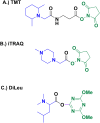Quantitative neuropeptide analysis by mass spectrometry: advancing methodologies for biological discovery
- PMID: 40529571
- PMCID: PMC12168976
- DOI: 10.1039/d5cb00082c
Quantitative neuropeptide analysis by mass spectrometry: advancing methodologies for biological discovery
Abstract
Neuropeptides are critical endogenous signaling molecules involved in a wide range of biological processes, including neurotransmission, hormonal regulation, immune responses, and stress management. Despite their importance, the field of neuropeptide research has been historically hampered by significant technical challenges. These include their low abundance in biological systems, diverse and complex post-translational modifications, dynamic expression patterns, and susceptibility to degradation. As such, traditional proteomics approaches often fall short of accurately characterizing neuropeptides, underscoring the need for specialized methodologies to unlock their biological and translational potential. This review evaluates state-of-the-art quantitative mass spectrometry (MS)-based peptidomics, emphasizing their impact on neuropeptide analysis. We highlight how strategies in label-free and label-based quantitation, tandem MS acquisition, and mass spectrometry imaging provide unprecedented sensitivity and throughput for capturing the landscape of neuropeptides and their modifications. Importantly, the review bridges technological innovation with practical applications, highlighting how these approaches have been utilized to uncover novel neuropeptides and elucidate their roles in systems biology and disease pathways.
This journal is © The Royal Society of Chemistry.
Conflict of interest statement
There are no conflicts of interest to declare.
Figures








Similar articles
-
Management of urinary stones by experts in stone disease (ESD 2025).Arch Ital Urol Androl. 2025 Jun 30;97(2):14085. doi: 10.4081/aiua.2025.14085. Epub 2025 Jun 30. Arch Ital Urol Androl. 2025. PMID: 40583613 Review.
-
Decoding Neuropeptide Complexity: Advancing Neurobiological Insights from Invertebrates to Vertebrates through Evolutionary Perspectives.ACS Chem Neurosci. 2025 May 7;16(9):1662-1679. doi: 10.1021/acschemneuro.5c00053. Epub 2025 Apr 22. ACS Chem Neurosci. 2025. PMID: 40261092 Free PMC article. Review.
-
T-bet expressing Tr1 cells driven by dietary signals dominate the small intestinal immune landscape.bioRxiv [Preprint]. 2025 Jul 4:2025.06.30.662190. doi: 10.1101/2025.06.30.662190. bioRxiv. 2025. PMID: 40747421 Free PMC article. Preprint.
-
"In a State of Flow": A Qualitative Examination of Autistic Adults' Phenomenological Experiences of Task Immersion.Autism Adulthood. 2024 Sep 16;6(3):362-373. doi: 10.1089/aut.2023.0032. eCollection 2024 Sep. Autism Adulthood. 2024. PMID: 39371355
-
Short-Term Memory Impairment.2024 Jun 8. In: StatPearls [Internet]. Treasure Island (FL): StatPearls Publishing; 2025 Jan–. 2024 Jun 8. In: StatPearls [Internet]. Treasure Island (FL): StatPearls Publishing; 2025 Jan–. PMID: 31424720 Free Books & Documents.
References
-
- Stawikowski M. Fields G. B. Curr. Protoc. Protein Sci. 2012;69:18.1.1–18.1.13. - PubMed
Publication types
Grants and funding
LinkOut - more resources
Full Text Sources
Research Materials

